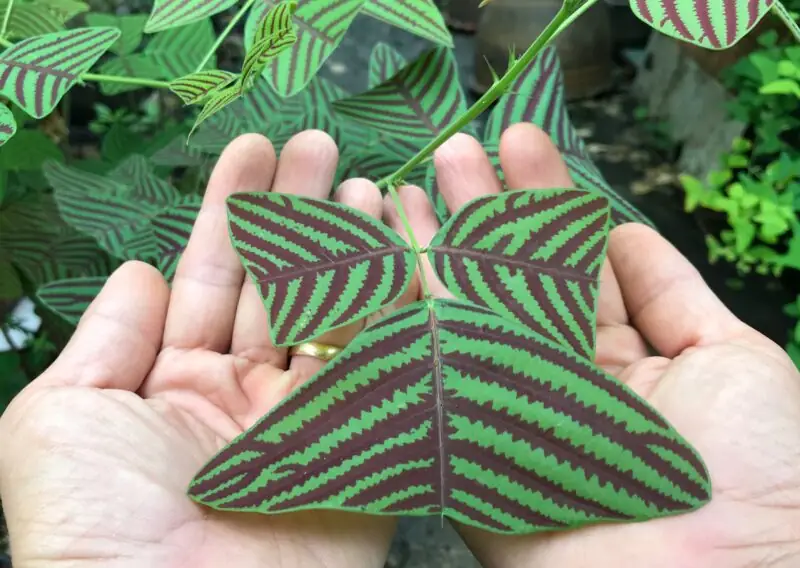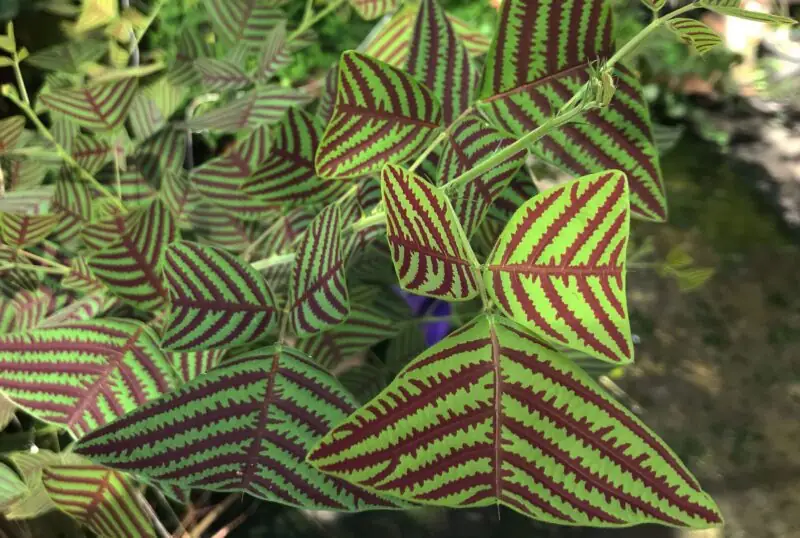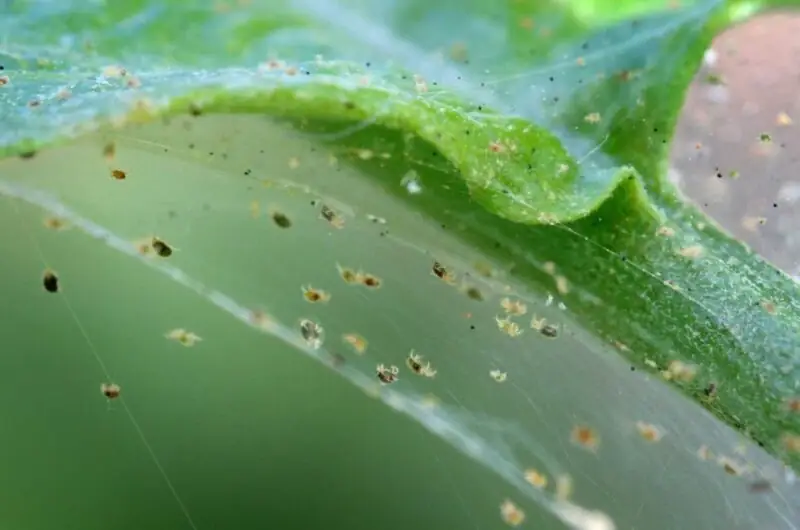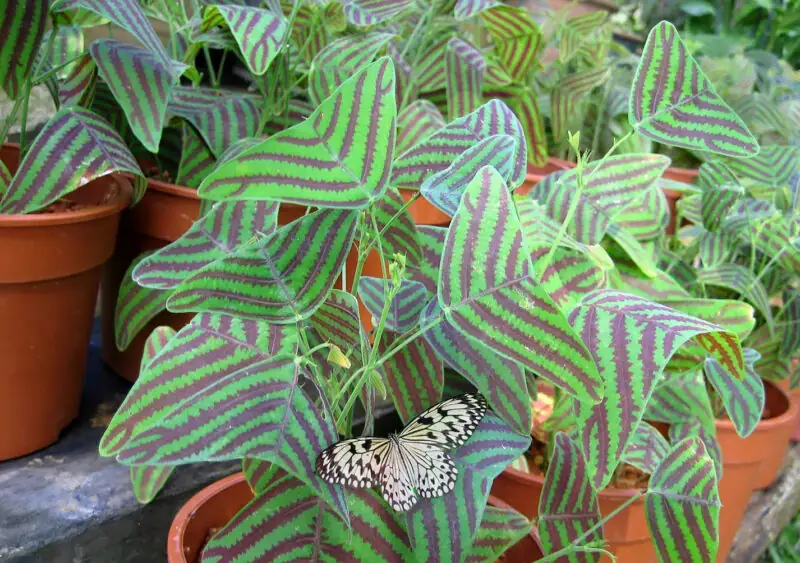Care Instructions for Your Swallowtail (Butterfly) Plant: Unveiling the Beauty of Christia Obcordata Flowers

Seeking a unique plant to be the star of your garden? Meet the swallowtail plant! Also known as the “butterfly plant”, this captivating species earns its name from its triangular-shaped foliage. These leaves boast a mix of green and burgundy, similar to a bird’s feather veins. The overall leaf shape mimics a butterfly’s wings, adding an appealing touch to any garden.
But what exactly is a swallowtail plant? How can you care for one at home or in your garden? This article covers everything you need to know about these beautiful plants. From their ideal growing conditions to soil preferences, propagation techniques, and potential problems, we’ve got you covered. So let’s get started!
What Exactly Is A Swallowtail Plant?
Botanical Description
The swallowtail plant, scientifically named Christia obcordata, is part of the Fabaceae family. This family is also known as Leguminosae, which includes popular ornamental plants like wisteria and lupine.
Native to tropical regions such as Central America and South America, butterfly plant are typically small. They can be shrubs or perennials, growing up to 2-3 feet tall. The leaves arrange alternately on their stems.
A unique feature of this species is its leaf shape. The leaves are triangular-shaped with deep indented veins. These veins resemble those found on bird feathers or butterfly wings. This distinctive look makes them stand out among other flowering shrubs.
Where Can You Find The Butterfly Plant?
You can find these beautiful plants at most local nurseries. Various online shops like mygardenlife.com also sell them. They offer different varieties, with prices ranging from $15 – $30. The price depends on whether the plant is already mature or not yet fully grown.
With proper care, you’ll see plenty more blooms of intense yellow and green swirled flowers. Though it’s quite a hardy species, Christia obcordata still requires proper care and attention.
How to Care for Your Swallowtail Plant?

Swallowtail plants are unique and beautiful. They’re also easy to care for. The plant’s triangular-shaped leaves have green and burgundy veins. They look like the veins of a bird’s feather. The overall leaf shape looks like a butterfly’s wings. This is why we call it the “swallowtail.” This unique plant is sure to be a star in any garden or room.
Lighting
Swallowtail plants are great with light. They can adapt easily. They can thrive in full sun or partial shade. But, they prefer bright but indirect light most of the year.
Are you growing your swallowtail plant indoors? Place it near an east-facing window. It can receive plenty of morning sunlight there. It won’t get exposed to harsh midday rays.
Watering: How Much Is Enough?
You should water your swallowtail plant consistently. But do it moderately. Do this throughout its growing season. This usually spans from late spring through summer. Do not let the soil moisture get too dry. This could stress the new growth. It could also result in yellow leaves due to nutrient deficiencies.
On average, water once every two or three days. This should be enough. The soil should feel moist several inches down. You can check this by gently pressing your fingers into the topsoil. But, never let standing water accumulate around the roots. This may lead to root rot over time.
Soil Preferences
The ideal soil mixtures have good drainage properties. This could be peat moss mixed with sand. It could also be compost-rich soils like loamy soils. These have rich organic matter. They retain adequate moisture levels. They also promote healthy root development.
Avoid giving the plant high nitrogen content fertilizer. Do not do this before transplanting seedlings outdoors after germination indoors. High nitrogen fertilizers encourage excessive leaf growth. This leads to weak stems. These are susceptible to breaking in strong winds or heavy rain.
Temperature And Humidity Needs
Swallowtail plants prefer warm temperatures. These range between 68 and 75° Fahrenheit during growing seasons. They’re not particularly fussy about humidity levels. But, they tend to thrive in more humid environments. Consider placing a small tray of water near the plant’s base. You can also group it with other moisture-loving plants. This increases humidity around them naturally.
During winter months, growth slows down. This is due to less daylight hours available. This usually happens from late autumn through early spring. Reduce watering frequency as needed during this time. The soil should remain consistently moist but never soggy damp!
Pruning: When And How?
Prune your swallowtail plant regularly. Do this throughout its growing season. This helps it stay bushy and healthy. Pinching off the tips of new shoots encourages branching. Removing dead leaves and stems helps prevent disease spread.
When pruning, make sure to use clean sharp tools. Sterilize these with an alcohol solution. Remove any diseased tissue before cutting away.
To avoid weakening branches, cut stems at an angle. Do not cut straight across. Cut just above the node where the leaf attaches to the stem. This promotes quicker healing. It also prevents rot from setting in. This can happen after a wound caused by a pruning blade.
Fertilizing: What You Need To Know
Swallowtail plants need regular fertilization for optimal growth. Use only half-strength balanced liquid fertilizer. Do this once every two weeks during active periods. These are usually in the spring and summer. Then, reduce the frequency gradually. Stop as dormancy sets in during fall and winter months.
Propagation: How to Increase Your Collection?
Are you fond of the unique and vibrant swallowtail plant? You may want to grow your collection. Luckily, propagating this plant is easy. You can do it through stem cuttings or seeds.
Propagation Through Stem Cuttings
A common method to propagate the swallowtail plant is through stem cuttings. This process involves cutting a healthy stem. Then you plant it in soil until roots form.
- First, choose a healthy branch. It should have at least two sets of leaves. Using sharp scissors or pruning shears, make a clean cut. It should be at an angle just below one set of leaves. This leaves no jagged edges.
- Next, remove any leaves on the bottom half of the cutting. Then dip it into rooting hormone powder. You can find this at most gardening stores. Once coated, insert the base into well-draining soil. Compost and sand can help with drainage. Press down gently around your new cutting. Add water until it’s moist, but not soaking wet.
- Place your cutting in indirect light. New plants may need more shade than mature ones.
- Keep them moist over several weeks. Check daily for signs of drying out or wilting. These signs could show insufficient watering.
After about 4-6 weeks, roots should form. Gently tug on stems. If there is resistance, you’ve successfully created another beautiful plant!
Growing From Seeds
Propagation via seeds requires patience. But it gives great results. Each seed carries its genetic differences. This leads to color variations within the foliage. Each plant is different yet stunning!
- To start, select a high-quality seed mix. Preferably one designed for swallowtail plants.
- Fill your pot with peat moss.
- Sprinkle the seeds on top. Then lightly cover them with more soil.
- Water gently but thoroughly. Avoid washing away any of the seeds.
- Place the pot in direct sunlight for optimal growth. To provide humidity, place a clear plastic bag over it.
- Keep an eye out for germination. This typically occurs within two weeks. It depends on temperature conditions. Higher temperatures lead to faster sprouting rates!
- Once little green shoots appear, remove the covers. Continue watering regularly. Avoid watering too frequently or sporadically.
- Aim for consistently moist soils. Also avoid excessive crowding. This could lead to disease infestations.
Common Problems and How to Solve Them
The swallowtail plant is a unique and attractive addition to any home or garden. But like all plants, it can have problems. By understanding potential issues, you can keep your Christia obcordata healthy and thriving.
Preventing and Treating Sunburn
Swallowtail plants can suffer from sunburn. They love sunlight, but too much direct exposure can lead to brown patches on their leaves.
To prevent this, avoid placing your plant under full sun during peak hours (11 am-3 pm). Provide shade with mesh cloth. If you notice brown spots on leaves, don’t panic! First, remove any affected parts. Then reduce light levels and keep soil moist.
Root Rot: Identification And Treatment
Root rot happens when fungi thrive in overly-moist environments. It damages roots, leading to wilting foliage and leaf drop. Eventually, the entire plant dies.
To prevent this, ensure good drainage. Also, check the pot size and placement against root growth requirements. If root formations are unhealthy, reduce watering temporarily. Let the top layer dry before the next watering session. Applying antifungal agents like copper hydroxide solution can help.
Dealing with Powdery Mildew
Powdery mildew is a fungal disease. It appears on leaves as powdery white patches or spots.
If left untreated, these can develop into larger areas of damage. It’s caused by humid environments with low air circulation.
To prevent this, keep your soil consistently moist (not wet). Also, maintain proper spacing between plants for good airflow. Avoid over-fertilizing them too often. Keep them away from other susceptible crops like roses or strawberries.
If you see signs of powdery mildew on your swallowtail plant’s leaves, act quickly. Remove the affected parts using clean scissors to reduce spreading. Then apply organic controls such as neem oil sprays. These are effective against fungi growths and won’t harm beneficial insects.
Insect Infestations And How To Manage Them

Swallowtail plants attract various insect species. Their nectar-rich blooms are attractive to insects. It’s important to manage potential infestations early on. This way, these beautiful plants won’t suffer irreparable damages.
Common pests encountered while growing swallowtail plants include aphids, spider mites, and caterpillars. To manage these, check your plants regularly for signs of insects. This could be visible pests, a sticky residue on leaves, or damaged foliage. Using an insecticidal soap or neem oil can help control these pests. Also, introducing beneficial insects like ladybugs can help manage aphid populations.
Remember, the key to a healthy swallowtail plant is regular care and attention. With the right conditions and timely intervention, your swallowtail plant can thrive and continue to add beauty to your home or garden. Enjoy the process of growing and caring for these unique plants!
Attracting Butterflies with the Swallowtail Plant: Is It Possible?
Are you a passionate gardener? If so, you understand the role of pollinators and beneficial insects in your garden. A wonderful way to attract these helpful creatures is by creating a butterfly garden. The swallowtail plant is a unique plant that is sure to draw in these delicate beings.
Why Butterflies Love the Swallowtail Plant
Christia obcordata or “butterfly plant,” is unique. The common name of this plant comes from its triangular-shaped foliage. The foliage with green and burgundy coloring resembles a butterfly’s wings. This shape is quite attractive to butterflies seeking nectar.
The plant’s eye-catching foliage isn’t its only appeal. Its bright yellow flowers also attract butterflies during the blooming season. This yellow hue grabs attention from afar and acts as a signal for flying insects like butterflies.
Additionally, swallowtail plants provide food for butterflies. Their nectar-producing flowers feed adult butterflies. They also serve another important purpose. They provide the necessary food resources for caterpillar development!
How To Optimize Your Garden For Butterfly Attraction

We’ve explained why butterflies love the swallowtail plant. Now, let’s discuss how you can optimize your garden. It’s time to make it a welcoming habitat for butterflies!
Select Plants That Will Provide Sufficient Nectar Sources
When choosing flowering plants, consider their bloom periods. Aim to select plants such as daisies, milkweeds, coneflowers, and black-eyed Susans. These plants have different bloom periods. This ensures there’s always a nectar source available, regardless of the time in the growing season.
Also, consider using plants of various heights in your landscape design. Place lower-growing varieties at the front borders. Position taller plants further back along walkways. This design promotes flight patterns around areas where people often walk. It also ensures there’s enough nectar for all the butterflies.
Provide Water Sources
Butterflies need various water sources. These include dew, rainwater on leaves or flowers, and shallow puddles. Consider adding a shallow birdbath with large rocks inside for perching to your garden!
Ensure you place the birdbath away from direct sunlight. It can dry out quickly in direct sunlight. A shaded area helps maintain water levels over time. This allows more insects access to this essential resource.
Propagate Swallowtail Plants and Host Plants
Propagation is an easy way to increase your swallowtail plant count. This way, you don’t need to purchase additional specimens at high prices! You can either propagate these plants using stem cuttings or grow them from seeds. Both methods are relatively simple if done correctly.
Many caterpillars require specific host plants like parsley or dill. If you have these already growing in your garden, consider transplanting some. Place them in areas where swallowtails may be present. This is an effective way to enhance your butterfly-friendly garden.
FAQs
Are you thinking of adding a Swallowtail plant to your garden? You might have some questions. Let’s answer some of the most common ones.
Absolutely! In fact, growing a Swallowtail plant in your home can be a good idea. It allows you to control its environment and care. For best results, choose a bright area with indirect sunlight. The soil should drain well. It should stay moist but not waterlogged.
This unique plant is usually available at local nurseries or garden stores. It is also for sale in online stores like Amazon or MyGardenLife.com. They can deliver to your location.
The right zone for a Swallowtail plant depends on its variety. In general, they grow well in USDA hardiness zones 9-11.
Conclusion
In conclusion, the Swallowtail plant is a great choice for your garden. It is attractive and low-maintenance. This plant is sure to grab attention with its beautiful yellow flowers and red stripes. It attracts butterflies and other pollinators. It is also easy to take care of.
The Swallowtail plant is versatile: thrives both outdoors and indoors, likes warm, moist soil conditions, makes a fantastic indoor plant. It fits well with home decor items like bookshelves and coffee tables. It is easy to care for and tolerates different light levels. Even if you don’t have a green thumb, you should feel comfortable trying it!
So, why not add one or more of these unique and beautiful plants to your space today? You’ll be glad you did!